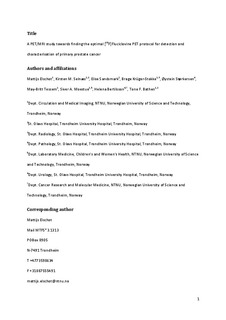| dc.description.abstract | Purpose:
[18F]Fluciclovine PET imaging shows promise for the assessment of prostate cancer. The purpose of this PET/MRI study is to optimise the PET imaging protocol for detection and characterisation of primary prostate cancer, by quantitative evaluation of the dynamic uptake of [18F]Fluciclovine in cancerous and benign tissue.
Methods:
Patients diagnosed with high-risk primary prostate cancer underwent an integrated [18F]Fluciclovine PET/MRI exam before robot-assisted radical prostatectomy with extended pelvic lymph node dissection. Volumes-of-interest (VOIs) of selected organs (prostate, bladder, blood pool) and sub-glandular prostate structures (tumour, benign prostatic hyperplasia (BPH), inflammation, healthy tissue) were delineated on T2-weighted MR images, using whole-mount histology samples as a reference. Three candidate windows for optimal PET imaging were identified based on the dynamic curves of the mean and maximum standardised uptake value (SUVmean and SUVmax, respectively). The statistical significance of differences in SUV between VOIs were analysed using Wilcoxon rank sum tests (p<0.05, adjusted for multiple testing).
Results:
Twenty-eight (28) patients [median (range) age: 66 (55-72) years] were included. An early (W1: 5-10 minutes post-injection) and two late candidate windows (W2: 18-23; W3: 33-38 minutes post-injection) were selected. Late compared with early imaging was better able to distinguish between malignant and benign tissue [W3, SUVmean: tumour vs. BPH 2.5 vs. 2.0 (p<0.001), tumour vs. inflammation 2.5 vs. 1.7 (p<0.001), tumour vs. healthy tissue 2.5 vs. 2.0 (p<0.001); W1, SUVmean: tumour vs. BPH 3.1 vs. 3.1 (p=0.771), tumour vs inflammation 3.1 vs. 2.2 (p=0.021), tumour vs. healthy tissue 3.1 vs. 2.5 (p<0.001)] as well as between high-grade and low/intermediate-grade tumours (W3, SUVmean: 2.6 vs. 2.1 (p=0.040); W1, SUVmean: 3.1 vs. 2.8 (p=0.173)). These differences were relevant to the peripheral zone, but not the central gland.
Conclusion:
Late-window [18F]Fluciclovine PET imaging shows promise for distinguishing between prostate tumours and benign tissue and for assessment of tumour aggressiveness. | nb_NO |
